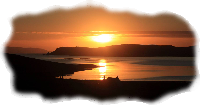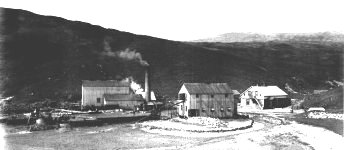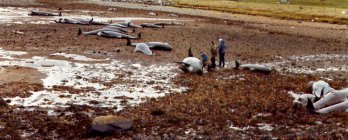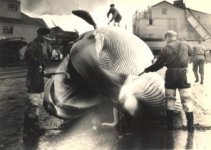


In 1903, following restrictions within Norwegian waters, two Norwegian owned whaling stations were built at Ronas Voe.
In April that year, the Zetland Whaling Company as seen on the left started with a single whale catcher named the Frithjof. The Norrona Company began in June with the catcher Norrona. They hunted whales until September and each boat caught just over 60 whales.
The whale catcher would bring the harpooned whale into Ronas Voe and fasten it to a buoy. The shore station would then bring it ashore when they were ready to process it. To get the huge whale carcass into the station, a chain was fixed around its tail and then an engine hoisted it up the ramp. Two Norwegian flensers, as seen below, would work with wires and winches to skin and remove the fat. Once the blubber was flensed from the whale, it was cut into strips and boiled, the resulting oil was then drained into wooden barrels for shipping.
The whale's crang or body was pulled deeper into the factory and chopped into lumps about two feet by two feet and put on a conveyer belt, up to where huge boilers were used to render the meat. It was then ground into meal, after being dried in the kilns. Afterwards it was loaded into 200 kilo bags and transported for use as a fertiliser.
In later years local men went to the Antarctic, this was when the first real prosperity from the whaling industry was seen in the islands, but by 1963 the southern stock of whales was also so depleted that all whaling expeditions involving Shetlanders came to an end.
Some interesting oral history recordings about whaling were made as part of HEARD's Past Present and Future project and they can be listened to at the Tangwick Haa Museum, Eshaness.
The nearest to a local whaling industry was when whales were driven ashore. The caa'in whales were usually between 8 and 20 feet in length and the blubber was stripped and then boiled for oil.
In 1741 when there was a famine in this area, people out of necessity did eat whale meat, but it was and never has been, considered as a normal food source in Shetland. In that same year, a single caa of 360 whales was driven ashore at Hillswick and yielded between two and four barrels of oil each.
The pilot whale in Shetland is known as the caa'in whale, caa means drive and this type of whale allows itself to be herded, even into shallow water. Up to the 1930's, if a school of pilot whales was seen, everyman made for his boat and making as much noise as possible, they drove the whales onto the nearest beach, where they were killed for the oil they could produce.
Sometimes for no apparent reason whales become stranded or beach themselves.
In 1983 as the daylight came up, folk on the way to and from work saw a horrific sight on the beach at Urafirth.
As can be seen from the photo, forty whales had beached themselves. The men of the area worked for hours, often standing to their waists in freezing water, as they tried to re-float the Long-finned Pilot whales that were still alive.
No reason is known why they do this and it is even harder to understand why, when they are set free, they turn round and head back onto the beach. By the end of that grim day only eight whales had been successfully re-floated and saved.
Thankfully beached whales on this scale do not happen often, it is more usual for only the odd one or two whales to be stranded and they are frequently found to be sick.
For another whale related story, read about the Hull whaler Diana.

It is sad to think that Shetlanders never had a real share in the wealth made from whaling, having had no locally owned industry; they only ever worked for others aboard catchers or on shore stations.
At Ronas Voe there was work available for some local men, but there was a great deal of agro against the factories because of the stench and the polluted beaches.The herring fishermen also complained that blood and offal from the whaling stations were attracting sharks that frightened off the herring shoals.

Eventually restrictions were imposed on the whalers, that all the whales caught had to be processed within 60 hours of being slaughtered. There was to be no harpooning within three miles of the coast and no whaling would be allowed from November 1 to March 31. By 1920 both whaling stations at Ronas Voe had closed down.
Whaling was not a new experience for Shetland men, as they had been going to Greenland to hunt the whales and seals for decades before this, although in the past, it was not easy for a young man to choose whaling over fishing, for if he decided to sign on a catcher he faced having his rent increased, to compensate the laird for loosing him as a fisherman.
